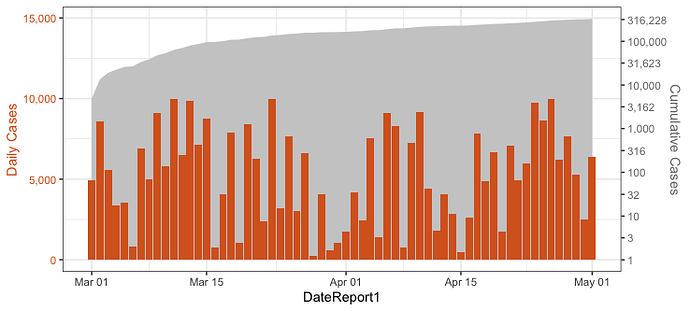You haven't provided data, so I've assumed in the fake data below that TotalCases_log10 is already on the log scale.
The general idea is to multiply the plotted second-axis values by a ratio that will put them on the desired vertical scale relative to the first-axis data. Then, in sec_axis invert that transformation (divide instead of multiply) to get the original values back for the axis scale. In this case, we also transform the axis labels from logarithms back to their actual values.
library(tidyverse)
theme_set(theme_bw())
# Fake data
set.seed(2)
CountryData = tibble(
DateReport1 = seq(as.Date("2020-03-01"), as.Date("2020-05-01"), "1 day"),
NewCases = sample(100:10000, length(DateReport1)),
TotalCases_log10 = log10(cumsum(NewCases))
)
# Ratio of largest NewCases value to largest TotalCases_log10 value
# Also multiplied by 1.5 to make the grey area plot extend above the bars
ratio = 1.5 * with(CountryData, max(NewCases)/max(TotalCases_log10))
ggplot(CountryData) +
geom_area(aes(x=DateReport1,y=TotalCases_log10*ratio), fill="grey80") +
geom_col(aes(x=DateReport1,y=NewCases), fill="#D86422",size=0.6) +
scale_y_continuous(labels=comma, name="Daily Cases",
sec.axis = sec_axis(~ ./ratio,
labels=function(x) comma(round(10^x), accuracy=1),
breaks=c(0:5, 0:5+0.5),
name="Cumulative Cases")) +
theme(axis.text.y=element_text(colour="#D86422"),
axis.text.y.right=element_text(colour="grey50"),
axis.title.y=element_text(colour="#D86422"),
axis.title.y.right=element_text(colour="grey50"))
